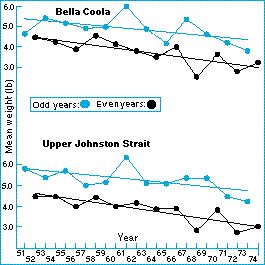Directional selection

Natural selection may be directional: it may favor, for example, smaller individuals and will, if the character is inherited, produce a decrease in average body size. Directional selection could, of course, also produce an evolutionary increase in body size if larger individuals had higher fitness.
Directional selection has been studied using artificial selection experiments. Natural selection can also be stabilizing or disruptive.
Figure: directional selection by fishing on pink salmon Onchorhynchus gorbuscha. The graph shows the decrease in size of pink salmon caught in two rivers in British Columbia since 1950, driven by selective fishing for the large individuals. Two lines are drawn for each river: one for the salmon caught in odd-numbered years, the other for even years. Salmon caught in odd years are consistently heavier, presuambly because of the two year life cycle of the salmon. From Ricker (1981).
Did directional selection cause a decrease in the size of pink salmon?
| Next |



